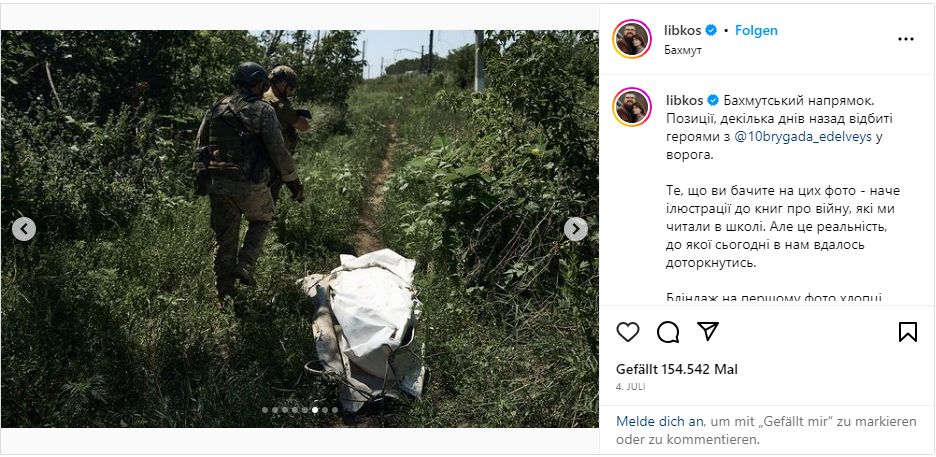News
15.11.2023
Lasting Wounds by Aleksandra Marchenko
by Eyes & Ears of Europe

Russian missiles and the increasing violence of the full scale invasion to Ukraine has been changing the understanding of a body and its beauty. For Ukrainians it is now wider than anything physical or aesthetical and broadens to the personal stories filled with wounds.
This writing is an attempt to reflect such changes. And also an attempt to overcome the language of statistics that leads away from real people whose lives turned into a battlefield on February 24, 2022 and earlier in 2014.
Reevaluated beauty
On the cover of the summer 2023 issue of Playboy Ukraine you will see model Iryna Bilotserkovets and her immaculate body, fragmentary covered with underwear that looks like a delicate variation of the armor. What one cannot see in this photo is that the skin on Iryna’s face protects titanium that replaces a part of it. In February 2022 when driving in the Kyiv region she was wounded at the shelling and lost her eye.
I have been closely following the visual reflections on new reality and “beauty standards” that have been changing in Ukraine along with the growing violence of this war. They outgrew the aesthetics. There is hardly ever something more beautiful or attractive for Ukrainians now than the military protecting their land and life, and nothing less so than passivity or indifference.
Iryna from Playboy cover traveled to the frontline to present the new issue to the military. It tells the stories of women who were injured during full-scale invasion of russia to Ukraine and not available for sale. The editorial team calls it “a missile of kindness and beauty” and disseminates the magazine amongst the military bases and hospitals as a sign of support.
Looking at fashion that mirrors societal changes, “Indposhiv” was the first on my radar that captured the new “stylish”, the same as Playboy did with “seductive”. Kyiv-based studio that produces bespoke suits for “the best men of the country”, chose the faces of the war to be the faces for their collections. First Masy Nayem, known lawyer who joined the army, was heavily injured at the frontline and lost his eye, then Ilya Samoylenko, a hero from “Azov” battalion who went through Azovstal defense and then russian captivity.
Expanding inclusivity
The celebration of new beauty is a series of photos by Lviv-based photographer Marta Shyrko. The bodies of the military with the signs of the war, large burns, scars and missing parts are united in her “Sculpture Series”. Thanks to the particular lighting, the fabrics Marta uses to cover her heroes, and their poses, her photos look like painted masterpieces.
When visiting the Louvre for the first time she saw sculptures without parts of the body, such as The Venus.The oeuvres that attract visitors from all over the world became her inspiration. She then decided to create the photos with Ukrainian soldiers presented as the oeuvres themselves.
- I wanted to praise and thank our warriors who defend our land at the frontline and come back wounded with lost parts of their bodies, the photographer explains to me.
Marta’s pictures are highly aesthetic and the reality is less so. After the photoshoots when walking down the stairs and taking the taxi to go home Marta realizes that many of the people she photographs are not able to walk down the stairs, nor can they go home.
- This realization is heavy, she says.
With “Sculpture Series” the photographer also starts the discussion around tolerance and inclusivity, the terms that broadens their meaning in the conditions of the war.
- We are wounded physically and psychologically and need to live with it and each other.
Tolerance and inclusivity declared as normal at the civilized societies often had remained theoretical even before the war. Marta photographed only one woman soldier so far. She still hears the comments that the scars make a man look like a hero and don’t serve any good for a woman. And the photographer invites to change it.
Now it is impossible in Ukraine to turn a face off from people with wounds simply because there are already too many of them. And all the physical wounds are the signs of the fight and survival. The signs of the pain that we all share, the pain caused by russian terror.
- We need to activate love to a person with whatever body they have, emphasizes Marta.
White bags
If on Instagram you find a page of Libkos, photographers duo who captures the war in the most artistic and realistic way possible, and scroll down to July 11, 2023, you will see a loving couple lying on a hospital bed. Andriy has almost no arms. Half of his face is recreated from the pieces of skin by the doctors. When a mine exploded under his foot Andriy lost both hands, eyes and became half deaf.
From what Libkos tell us, Andriy used to sing in a quire before the war. He then joined the army and became a head of the air intelligence unit. Now Alina, his wife, takes care of him in the hospital after the injury. In the photo she holds him lovingly with her arms around his tortured body.
Under their photos I find a comment from Ilona who says that injured Andriy was evacuated by her husband Oleksiy. Oleksiy wrote to her about a young handsome man and worried if he would survive. He also wrote that Andriy had most likely been married recently, same as Oleksiy and Ilona. He thought so because the note about the marriage was written by the pencil for both men.
By the time Ilona left this comment Oleksiy had been killed at the frontline. I open Ilona’s Instagram profile and see a very young blond shining lady. Most of her photos are about their love with Oleksiy, handsome Ukrainian with warm light eyes and long beard.
It’s the story around one photo only. The exact numbers of people who were wounded, tortured or killed by the russians since February 2022 and since 2014 are unclear. Only each number is an abruptly ended story of love and life.
- The language of officials and policemen is not personalized," explains Eugene Spirin, a volunteer who also works in a morgue. Dead people in the news and reports do not have the names, they are deceased persons and numbers.
Eugene manages a digital memorial of Ukrainians killed in Bucha at the beginning of the full scale invasion and recreates their stories.
- When I worked in a morgue I remember the day when I found a passport in the sock of a man and saw his photo, he recalls. I realized then it’s a person, not a body.
Amongst the victims of the atrocities in Bucha Eugene found the story of Mykola Stashchenko, born in 1935. A diver who served in the USSR army and dedicated himself to rescue people during the accidents of the submarines. In March 2022 when russians occupied Bucha he went out for some water and was killed in his head. Mykola was buried in the mass grave under the number 38.
Some Ukrainians remain without numbers and cannot be buried. When running from the shellings at the hottest positions at the frontline Vlada and Kostya Libervov (Libkos) pictured the white bags. They remain in trenches and underground military tents and cannot be removed from the frontline because russians often mine them. Ukrainian military sleep and eat near those white bags with the skeletons of their sworn brothers. Their names or stories remain unknown.
People, not bodies
In March 2022 I was in a crowd at the train station in Dnipro trying to evacuate. That’s when and where I felt the war. In a flood of people from Kharkiv and locals it was impossible to reach a platform or even to move. People were screaming, pushing each other in and out of the train cars while also holding pets and children in their hands. It takes up to twenty hours by train from Dnipro to the western border of Ukraine, and the trains took as many people as could stand in a car. All I was thinking then was “What if the next russian missile reaches us here”.
I didn’t make it to the train that day and took the last tram home before the curfew. There I saw a woman holding her big white cat in a small plastic cage. We smiled at each other, united by the same fortune. It was dark and really cold. That horrible weather when it rains and snows at the same time and the wind makes it impossible to escape from neither.
We still had about 20 min before the curfew but most of the street lights were off. The woman suggested we share a taxi instead of waiting for the next train. In the car, when the driver speeded up to the maximum, I told her I would not go over those women with kids and cannot imagine standing on a step of the train for hours.
- You should leave, the woman said and squeezed my hand trying to share the strength of her intention. They will bomb us again and again.
- But we are people, I screamed out all the absurdity of this terror that didn’t let me sleep or eat since February 24.
And we both helplessly bursted into tears.
It has been one and a half years since the beginning of the full scale war, and every day I want to scream the same words.
Republished from: https://www.kas.de/de/web/die-politische-meinung/artikel/detail/-/content/bleibende-wunden
Current Jobs
- Praktikant/in Marketing und Social Media (w/m/d) - ARD Programmdirektion, München
- Praktikant/In Talent and Music (m/w/d) Pflichtpraktikum - Paramount.+, Berlin
- Technical Coordinator (m/w/d) im Design- und VFX-Bereich - Hessischer Rundfunk, Frankfurt am Main
- Art Director Newstime (m/w/d) - Seven.One Entertainment Group GmbH, München
- Project Manager Creative (f/m/d) as a leave cover - Paramount. Berlin or remote







